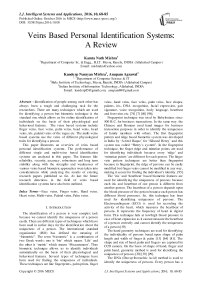Veins Based Personal Identification Systems: A Review
Автор: Kamta Nath Mishra, Kanderp Narayan Mishra, Anupam Agrawal
Журнал: International Journal of Intelligent Systems and Applications(IJISA) @ijisa
Статья в выпуске: 10 vol.8, 2016 года.
Бесплатный доступ
Identification of people among each other has always been a tough and challenging task for the researchers. There are many techniques which are used for identifying a person but biometric technique is the standard one which allows us for online identification of individuals on the basis of their physiological and behavioral features. The veins based systems include finger veins, face veins, palm veins, head veins, heart veins, iris, palatal veins of the rogue etc. The multi-veins based systems use the veins of different physiological traits for identifying a person. This paper illustrates an overview of veins based personal identification systems. The performance of different single and multi-veins based identification systems are analyzed in this paper. The features like reliability, security, accuracy, robustness and long term stability along with the strengths and weaknesses of various veins based biometric approaches were taken into considerations while analyzing the results of existing research papers published so far. At last the future research directions in the field of veins based identification systems have also been outlined.
Face veins, Finger veins, Hand veins, Heart veins, Multi-veins, Palatal veins, Palm veins
Короткий адрес: https://sciup.org/15010868
IDR: 15010868
Текст научной статьи Veins Based Personal Identification Systems: A Review
Published Online October 2016 in MECS
The identification of a person is very complex task because we cannot identify the uniqueness of a person easily. There are different types of techniques which have been used in earlier days for the identification about the uniqueness of a person. The international standard organization (ISO) has defined the meaning of “biometric”. The term “biometric” is a combination of two Greek words: one is ‘bio’ which means ‘Life’ and the other is ‘metric’ which means ‘Measurement’. Thus biometric technique allows us to identify individuals automatically on the basis of their physiological and behavioral features. Several types of techniques have been used for finding the uniqueness of individuals. These techniques are like fingerprints, palm prints, finger veins, hand veins, face veins, palm veins, face shapes, palates, iris, DNA recognition, facial expression, gait signature, voice recognition, body language, heartbeat and foot veins etc. [74] [7] [40] [96].
Fingerprint technique was used by Babylonians since 500 B.C. for business transactions. In the same way, the Chinese and Romans used hand images for business transaction purposes in order to identify the uniqueness of family members with others. The first fingerprint pattern and ridge based biometric system was developed in India by ‘Azizul Haque’ for ‘Edward Henry’ and this system was called “Henry’s system”. In the fingerprint technique, the finger ridge and minutiae points are used for identifying individuals because every ‘ridge’ and ‘minutiae points’ are different for each person. The finger vein pattern techniques are better than fingerprint because in fingerprint, the ridge of persons can be easily modified but finger veins cannot be modified in any way, making it secure for finding the individual’s identity. [95].
The ‘iris’ and ‘heartbeat’ based biometric features are used for identifying the uniqueness of persons because each iris and heartbeat of one person is different from another person. The heartbeat of a person depends upon the blood pressure of the person because each person has different blood pressures. So, this technique has been used for identifying uniqueness of persons. The Electrocardiogram (ECG) is used for recording the activity of the heart, which measures the heartbeat of persons. It represents the frequency of heart in digital form. This technique fails at low/high blood pressure in case of heart expansion as it cannot measure the heartbeat of a person correctly and cannot identify the uniqueness of a person [19].
The DNA (Deoxyribonucleic Acid) method is used to identify the uniqueness of persons. Every person has a unique DNA sequence which is used for offline identification of a person. This technique gives the best result for identifying the individuals except identical twins; because identical twins bear the same DNA structure. Here DNA based matching techniques are not useful for identifying the individuality of persons. The face vein based technique is used for identifying the uniqueness of a person. This technique cannot be modified easily in any circumstance [36].
The spectrum range of Far-Infra-Red (FIR) camera lies between 8-14 micrometers, and is used for capturing the effective vein images. The infra-red light passes through the tissues of human body. The hemoglobin absorbs the infra-red light and then the vein patterns can be captured with the help of infra-red camera from the finger [61] [80] [89].
There are two types of palm print resolutions; one is high resolution image which is used in forensic applications for identifying the criminals and second is low resolution image which is used in commercial applications for finding the individuality of a person [41]. The high resolution image range is 400dpi or more and low resolution image range is 150dpi or less. We extract the palm print images for getting the ridge and minutiae points for finding the individuality of a person. There are five objectives of biometric systems which are: cost, user acceptance, environment constraints, accuracy, computation speed and security. Fusion based techniques are better for finding the individuality of persons. There are three types of categories of fusion based techniques; these are: pixel level fusion, feature level fusion and score level fusion [12] [18].
The veins pattern based recognition technique is more efficient technique in comparison to other techniques for identifying individuals. The veins exist under the skin of a person, responsible for carrying blood in the whole body of a person. Human veins are stabled and unique for each person, so vein based techniques are used in these days [83] [64]. The Near Field Communication ID
(NFCID) and Finger Vein Authentication System (FVAS) technologies are used to identify the individuals for security purposes. The FVAS technique performs on the basis of physical behavior of human body parts, and then identifies the person. The finger vein classification algorithms are also used for identifying uniqueness of persons. The finger vein images appeared either bright or dark and the vein images do exists in vessel network of humans [77] [94] [97]. In the field of vein based identification system, embedded hardware systems are used for finding the individuality in complex situation. The FPGA technology implementation is based on the biometric and image processing algorithm for identifying the person.
-
II. B ACKGROUND OF V EINS B ASED S YSTEMS
The veins based images like head veins, face veins, palatal veins, heart veins, hand / finger veins and palm images are presented in fig. 1. These images are used for identifying the persons from others. The veins based technique is widely used in these days because these techniques cannot be modified or falsified. The veins of humans are stabled and unique until the human is in living stage. Any other technique that is not based on vein based recognition system, then an expert person can easily modify the techniques like finger prints, palm prints, hand shapes and face shapes recognition systems. These techniques do not identify the uniqueness of a person in complex situations. Due to these reasons, vein based technique has an advent in the field of security system [17] [86] [91] [92] [99].
The veins based security system is much more secured than other security systems. At the starting of this technique finger vein based identification system has been used; then palatal based identification system has been used for identifying the individuals. Then after the face vein based technique is a new identification technique which is widely used during these days; because face veins are unique for each person but finger veins, hand veins, palm vein, heart veins might match with other persons. Due to these reasons, face vein based identification system are used. The face vein images are captured by thermal cameras from optical image. After obtaining the thermal image, extraction feature method is used for obtaining the
Veins image of a person.
The local binary pattern (LBP), local directional code (LDC), poly-directional local line binary pattern (PLLBP) and Gabor filter are used for recognizing the face and finger prints. The LBP is easily affected by image noise. The Gabor method based upon filters which are not much effective in vein recognition image representation [50] [87].
The veins images exist only in living human body [105] [106]. In each uni-modal, the feature extraction and feature matching algorithm for identifying the individuals was firstly described on the basis of face veins, hand veins, finger veins and palm veins images which are not easily modified [96].The multispectral palm print image is generated from palm veins of a person, then it is compared with other person’s palm veins images for identifying the individuals [115]. Veins based identification systems are the part of physiological feature based systems because extracted veins represents physiological features of a person.
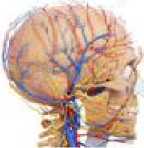
1(a) Head veins image
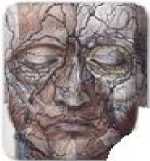
1(b) Face veins image
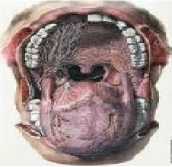
1(c) Palatal veins image
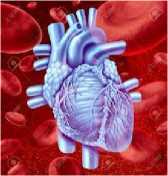
1(d) Heart veins image
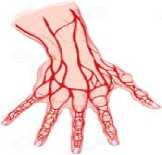
Fig.1. Veins image based personal identification of the person
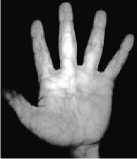
1(f) Palm veins image
-
A. Why Veins Based Systems?
Vein based identification systems are being widely used these days because other techniques like finger prints, palm prints, hand geometry, facial expressions, skin color, voice recognition, gait signature, body language, DNA recognition and heartbeat recognition systems are unable in identifying the twin persons. Also, the fingerprint can be easily modified with the help of plastic surgery; and other techniques do not gives the appropriate result in the complex situations. Thus, a person cannot be identified due to these reasons. Therefore, veins based techniques are required for identifying the individuals. The vein based technique identification cannot be modified easily, so this technique is widely used during days.
The veins based identification systems takes less space in memory for storing in the database. We can reduce the size of visual images after converting them into vein based identification system. With the help of database, the image of a person can be matched with database’s image of the person. If both of the images match, then the person will be same, else different.
-
B. Classification of Veins Based Systems
Veins based identification systems are classified into two categories namely uni-veins systems and multi-veins systems. In uni-veins based system, the veins of single physiological feature are used for identifying a person. The examples of uni-veins based identification systems are: head, face, iris, palatal, heart, hand, fingers and palm veins based identification systems. In multi-veins based system, the veins of two or more physiological features are used for personal identification.
-
C. Merits and Demerits of Veins Based Identification Systems
The demerits of veins based personal identification systems are that if the veins images of a person are damaged due to accident or burn then veins based technique may not work accurately for identification.
-
III. U NI -V EINS B ASED I DENTIFICATION S YSTEMS
The mostly used uni-veins based identification systems are: face, fingers, hand, palm, iris and palatal veins based identification systems. These veins based identification systems with their corresponding merits and demerits are presented in this section.
-
A. Head / Face Veins Based Systems
Head and face veins based identification systems are used to identify the uniqueness of the person with the help of head veins or face veins. It is because head / face veins of a person will not be changed at any situation in terms of veins structure. The veins based systems take smaller space in memory for storing its database.
The head veins of the persons are obtained from visual head image with the help of CT scan devices. These CT scan devices use Infra-Red rays for obtaining the veins pattern of the person. The Infra-Red rays are absorbed by the blood vessels; due to this reason veins images are emerged and used for the identification process.
The face veins of persons are obtained from visual images with the help of Near Infra-Red (NIR) or Far Infra-Red (FIR) cameras [1] [20] [42] [45] [46]. After obtaining the thermal images, MATLAB functions are used for extracting the thermal images of the person. The fig. 2 is representing that how the face vein image from thermal images are retrieved.
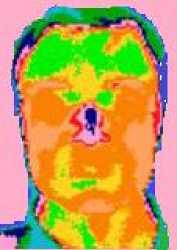
2(a) Thermal image
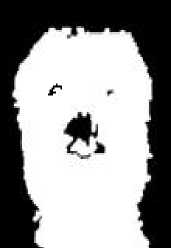
2(b) Face skin region
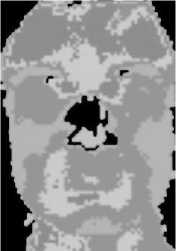
2(c) Cropped face image
Fig.2. Retrieved face vein image from thermal image [68].
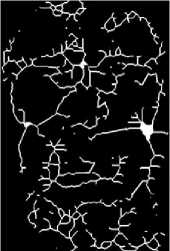
2 (d) Face vein image
R=Φ ⊕ S (2)
In Eq. (2), ‘ S’ is representing spherical structural elements of localization radius and ‘ ⊕ ’ is representing dilation operator. With the help of Eq. (2), the inner and outer boundary contour is found which is used in the image segmentation process. After completing the face segmentation process, the noise removal process is used. The noise removal process is mathematically described in Eq.(3).
C ( x , У , t )=" || VI | | (3)
The steps which are required for obtaining the vein’s image from optical image of a person are:
Step1: Capture thermal image from visual image.
Step2: Feature extraction method.
Step3: Result comparison.
-
(i) Capturing Thermal Image from Visual Image of Head / Face Veins
In this step we collect the thermal image from the optical images of head / face veins with the help of infrared cameras like Mid Wave Infra-Red (MWIR), Short Wave Infra-Red (SWIR) and Merlin MWIR camera. These cameras must be placed at the distance of one meter from the object [66] [72] [76] and the room temperature should be 230c approximately.
-
(ii) Feature Extraction Method
After obtaining the thermal image we have used extraction method for displaying the veins from the thermal image of the person. In extraction method, first the thermal image is registered. There are various techniques which are used for registering the image like FMRIB software library. FSL are used for registering the image. Another technique is FMRIB Linear Image Registration Tool (FLIRT). This technique is a much better technique from other techniques for registering the thermal image [6] [10] [58] [70]. After registering the thermal image we have performed the thermal signature extraction process. In this process the thermal images are segmented in the form of face, neck and unwanted things like hair, nose, ear, neck etc. These are removed in the thermal signature process [54] [28] [60]. The segmentation process is explained mathematically in Eq. (1).
In Eq. (3), ‘ ∇ I ’ represents the calculated value of eight directions and ‘K’ is representing the gradient modulus threshold value that controls the conduction and avoid the blueprint of facial features. Which is used for removing the noise from the thermal face veins image, with the help of standard filter like Perona Malik filter, diffusion filter and Gabor Filter etc.[11] [52]. The image morphology methods are used for analyzing the shape and size of face vein images like length and breadth of face vein image. After completing the noise removal process, the template and signature of object will be generated and then it is matched with other person and the result is obtained [23] [24].
The local binary pattern (LWBP) and Haar wavelet transform (HWT) techniques are used for identifying the individuals in TFRS system which is used for identifying the individual [67].
(iii) Result Comparison
After completing the feature extraction process, the result comparison process will be applied for comparing the results of each technique. There are different types of techniques which are used for identifying the uniqueness of the persons here. Every technique is compared with each other on the basis of its performance, which is given in the table 1.
( 1, ∅( X )<-
∅( х )=
0,
∅( X )>Е
| ,1+ ∅ + + sin- ∅() }, ot ℎ erwise
2 1 E Л £ J
In Eq. (1) Φ(x) represents initial contour and [-ε, ε] represents the boundary of Heaviside. The value Φ(x) is used in Eq. (2) for finding optimal segmentation which is represented in Eq. (2).
Table 1. Comparison of different face veins based identification techniques on the basis of performance [1] [20] [42] [45] [46].
|
S. No. |
Techniques |
Features Used |
Performance in % |
|
1 |
LWBP & HWT |
Minimum distance |
89-94 |
|
2 |
FLIRT |
Distance based similarity |
90.39 |
|
3 |
TFRS |
97.62 |
|
|
4 |
Fuzzy CMAC Model |
Angular distance |
86 |
|
5 |
Vascular Mapping and Multi resolution analysis |
Vascular map |
93 |
|
6 |
FFT |
Pulse rate |
90.33 |
|
7 |
SIFT & SURF |
Maximum Pixel Distance |
95 |
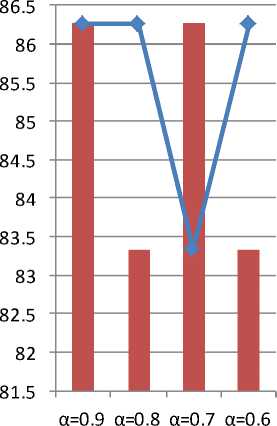
94.11
89.22
and and and and β=0.1 β=0.2 β=0.3 β=0.4
Fig.3. Compared performance of own database with Terravic Facial Thermal Database using HWT technique [67].
-
B. Hand / Finger Veins Based Systems
The hand / finger veins based identification systems are widely used as same as the face veins based identification systems. The hand /finger veins based system cannot be modified with the help of plastic surgery or any other technique. The execution time of this technique is very less for identifying the person from the database of the system [50]. This technique used infra-red camera for capturing the thermal images from the visuals for obtaining the finger veins images. There are different steps which are used for completing the process for identifying the uniqueness of the person on the basis of hand / finger veins based systems. The steps are as follow:
Step1: Capture the thermal Finger Veins Image.
Step2: Extraction and Image Segmentation Feature.
Step3: Techniques Used for Identifying the Persons.
Step4: Result Comparison of Different Techniques on the Basis of their Performance.
-
(i) Capture the Thermal Hand/Finger Veins Image
Hand and finger veins based identification systems are used for identifying the individual on the basis of hand and finger veins. The finger veins and hand veins are captured with the help of NIR, SWIR and MWIR cameras. The hand veins are taken with the help of low resolution cameras [93] [107]. There are three types of scanning devices that are used for capturing the hand and finger veins. These are X-ray scanning, ultrasonic scanning and infra-red scanning devices [73] [75] [84]. As we know that the human body temperature is 36.850c [63]. The far infra-red (FIR) and near infra-red (NIR) cameras are used for obtaining the veins of fingers. The FIR CCD camera captured the upper surface of hand and finger; the FIR camera captured the low quality veins image of finger and palms of the person [112] [5] [8] [9] [15] [16] [32] [33] [82].

4(a) Original finger image


4(b) Enhanced finger vein image

4(c) Segmented finger vein image 4(d) Skeleton finger vein image
Fig.4. Represent the finger vein image from original image [101]
The wave length of NIR camera is between 700 to 1400 nm. The NIR camera is widely used for capturing the veins image of the persons. When we have captured the NIR thermal images, then its dimension was 640X480 pixels [92] [2] [4] [29] [51]. After converting this image into gray scale image; its size became 128×128 pixels. The Fig. 4 represent the enhancement of finger vein image, segmentation of finger vein image and skeletons of finger vein image from the original finger image of the person [90].
-
(ii) Features Extraction and Image Segmentation
After obtaining the thermal images, we have to convert them into gray scale images and then feature extraction process has to be applied. In feature extraction process, the gray scale image is converted into thinned image with the help of morphological function and then extraction methods are applied for removing the noise and unwanted things with the help of Gaussian Low Pass Filter (GLPF) and Gabor filters which are used for removing the high frequency noise from the images [101] [102] [56] [77] [83] [85] [92] [116]. The Gabor filter is useful for finding ridge direction of the images [22] [55] [43] [47] [92] [109]. The functioning of Gabor filter is mathematically described in Eq. (4) [105] [106].
G(x,y) = exp- V^-+ 77)) cos(2nfxe) (4)
Where,
5,1=[
cos 6 - SUI 6
sin 6 cos 6
1 [*]
fig. 5 describes complete steps which are required for identifying a person using finger veins.
In Eq.(4), ‘ f’ represents the filter center frequency,
θ=jπ/J, j={0, …,J} where ‘J’ represents orientation of parameter, ‘σx’ and ‘σy’ are representing the standard deviations in elliptical Gaussian envelop, ‘xθ’ and ‘yθ’ represent the rotated versions of coordinates (x, y) of Gabor filter [105] [106] [57] [113]. Now, morphological process or noise removal process along with the image segmentation process is used for extracting the veins from the thermal image with the help of extraction module.
In image segmentation the three types of operations are required. These operations are: Local Dynamic Threshold, Noise Elimination and Thinning Operation [110] [108] [103]. The local dynamic threshold technique is used for converting the gray scale images into binary-level images. In the binary-level representation, the images are in the form of black and white pixels [34] [53] [44] [48] [65] [78] [108]. The image segmentation process is important for extracting the finger veins of a person. The segmentation process is mathematically described in Eq.(5) and Eq.(6) [104].
d = line (i+1)-line (i) (5)
(I ine( i + 1) |d| < 3
I ine ( i + 1) = < I in e(i) + s gn(d ) 3 < |d| < 6 (6)
(Z ine(i) |d| > 6
The Eq. (5) is used to find the distance between two adjacent edge points of finger veins image. Where‘d’ represents the distance between two adjacent edge points, line(i) represents the edge points of ith row. The Eq. (6) is used to find the edge points from the finger veins.
In feature extraction process the brightness, normalization and size are necessary for the final matching of finger veins. The brightness and size must be normalized for each finger. The normalization area of finger is (200×100) pixels. The brightness normalization and size are mathematically described in Eq. (7) [104].
^
l(i, j) = m +-(I(i,j) - m) (7)
In Eq. (7), ‘I(i, j) ’, ‘m ’, and ‘σ’ are representing the brightness, mean and deviation of the finger veins before normalization and 7 (i, j), mi, o’ are representing the brightness, mean and deviation after normalization of the image [104].
The noise is eliminated with the help of binary median filter and then finally skeleton image is obtained. These images are in the form of single pixel width before proceeding in feature extraction process. These steps are performed by all identification systems which are widely used now days [25] [26] [30] [38] [71] [106]. The fig. 5 is describing about how a user can register the finger vein images into the database with the help of thermal camera or finger vein sensing device and how many steps are required for storing the veins images in the database. The
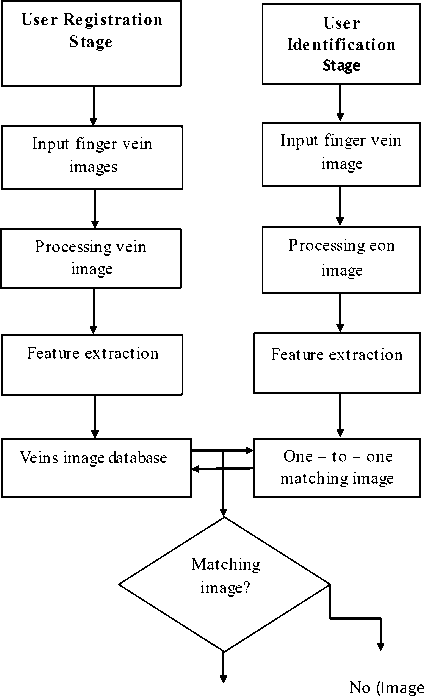
Yes (Image Accept) Reject)
Fig.5. Steps of matching the finger vein image from the database [92].
-
(iii) Techniques used for identifying individuals Using Hand / Fingers Veins Systems
There are many techniques which are used for identifying individuals on the basis of finger veins. The multimodal personal authentication using finger veins and face biometric identification (MPAFFI) technique uses unique features of finger veins and face images of a person for personal identification [103].
The SVM technique is also used for identifying individuals. This technique uses K-means clustering algorithm for automatic clustering of finger veins images. The k-mean clustering algorithm uses maximum and minimum distance algorithm for obtaining the optimal number of clusters. The highest value of silhouette is best clustering result. The biggest value of cluster is used for classification of finger vein images which are used for identifying the individuality of the person. The Gaussian PSF model is used for identifying the individual on the basis of finger veins. The Gaussian PSF model is mathematically described in Eq. (8).
g(x,y) = f(x,y) ⊗ h(x, y) + n(x,y)
h(x, y) = h s (x,y) ⊗ h l (x,y) (8)
In Eq. (8), g(x, y) represents the input, f(x, y) represents restore the image, ‘ ⊗ ’ denotes the convoluting operator, h(x,y) represents the PSF model of the finger veins based system, hs(x,y), h l (x,y) and n(x,y) represent the noise of the system. The Eq. (8) is used to obtain the clear finger veins image of a person for identifying the uniqueness.
The Eq. (9) describes mathematically, how to identify a person with the help of finger veins images in finger veins based identification systems.
| m = arg ^(Kv/v t )
I( (г.г^ = 1 - vrv j /(|lvl||lv t ||)
Here, ‘ v’ and ‘ v i ’ represent the unknown sample and a template in the ‘ith’ class respectively, ‘C i ’ represents the total number of template of ‘ith’ class, ‘||.||’ indicates the Euclidean norm and ‘d(v,v i )’ denotes the cosine similarity measure. The feature vector is classified into mth class with the help of cosine similarity measures [101].
The comparative competitive coding (c2 code) scheme is used for identifying the uniqueness of a person. This technique has used new features like junction point of finger veins and finger dorsal image fusion scheme for identifying the uniqueness of a person. In this technique, region of interest (ROI), feature extraction and fusion strategy are used for capturing the image, extracting the image and comparing the image. The Gabor filters have been used widely for performing the feature extraction process of the image. The PFS-PHGTOG technique is used to identify the uniqueness of the persons. The PFS-PHGTOG technique uses two stages namely training stage and recognition stage for identifying individuals on the basis of finger veins [95] [13] [37].
-
(iv) Performance Comparison of Hand and Finger Veins Based Identification Systems
0.05
0.04
0.03
0.02
0.01
The performance of different techniques used for identifying uniqueness of a person using hand and finger veins features are presented in table 2.
Table 2. Comparing the performance of hand and finger veins features based techniques [13] [37] [92] [95].
|
S. No. |
Techniques |
Features Used |
Performance in % |
|
1 |
MPAFFI |
Magnitude & Phase |
98 |
|
2 |
SVM |
Cluster |
99 |
|
3 |
C 2 code |
Lower EER |
99.54 |
|
4 |
SVD & RT |
Direction and Dimension feature |
FAR 0.020 FRR 0.000 |
|
5 |
RFID, NFCID & FVAS |
Frequency |
60-69 |
|
6 |
FVP |
Vector |
98 |
|
7 |
FPGA |
EER |
0.101 |
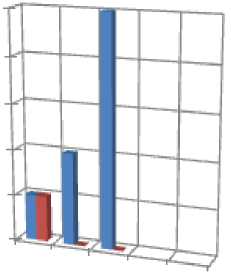
FAR
FRR
Fig.6. Radar graph of FAR and FRR based comparison of threshold distances [92].
The results of table 2 show that the C2 code technique has better performance than other techniques. The threshold distances and the corresponding false acceptance rate (FAR) and false rejection rate (FRR) ratios are represented by radar graph of fig. 6. Here, FAR and FRR values exist between 0 and 0.05.
-
C. Palm Veins Based Identification Systems
The palm veins based identification systems are used to identify the uniqueness of the persons on the basis of their palm veins images. The palm veins based identification techniques are related to the physiological feature of a person. The palm vein based techniques are widely used because palm print and other techniques have provided the appropriate results in terms of FAR and FRR. The palm veins based systems gives the accurate result in challenging tasks in any situation. In human skin, three types of key components have been observed which are epidermis, dermis and subcutaneous layers. Here, subcutaneous layer contains veins and arteries of palm image of a person [59] [114] [14] [79]
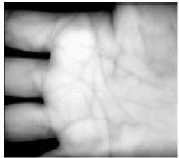
7(a) Actual palm image
7(b) Palm print image ■
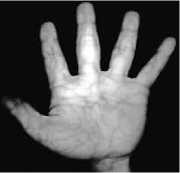
7(c) Palm vein image
Fig.7. Representation of palm vein image from the actual palm image [88].
7(d) Enhanced palm vein image
The palm veins images are captured with the help of high resolution infra-red cameras. The thermal cameras, colored cameras and low cost monochrome JAI CV-M50IR cameras are also used for obtaining the thermal images from the optical palm images [3]. The IR camera is not much sensitive to detect the IR radiation emitted by human body. The IR radiation ranges between 3000nm and 12000nm [88] [18] [49].
The steps of obtaining palm veins from original palm image are presented in fig. 7.
-
(i) How to Capture the Palm Veins?
In the palm veins based identification systems, the palm veins images are captured with the help of high resolution IR camera. The low cost monochrome JAI CV-M50IR, CCD IR camera and CMOS sensors are widely used in the palm veins based identification systems. The fig. 8 represents how to capture the palm vein image with the help of IR, CCD, MWIR cameras [31] [35]. The image extraction and noise removal steps are carried out for getting the actual palm veins.
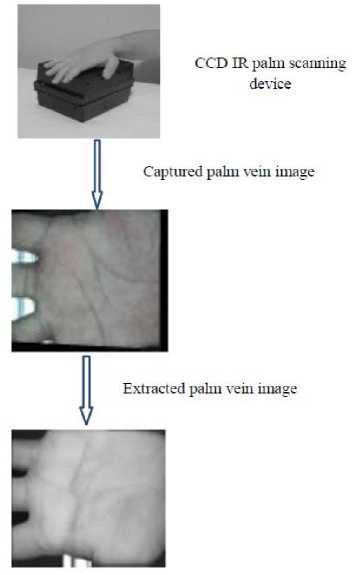
Fig.8. Capture the palm vein image with the help of CCD IR scanning device
-
(ii) Feature Extraction and Image Segmentation of Palm Veins Image
After capturing the thermal palm veins image, the feature extraction process is used for removing the noise from the thermal palm vein image. The Gabor filter, orthogonal Gaussian filter, cutoff Gaussian filter, matched filter, SIFT technique, ordinal code, SUSAN edge detector and Laplace methods are used in feature extraction process [88] [100] [114]. After completing feature extraction process the palm veins images are further converted into template form at the time of identification of a person.
In the multispectral palm veins, more focused comparison is required in comparison to single spectral palm veins. In the real world application of palm veins based identification system NIR based palm veins images are widely used [27] [36] [41] [[98] [115].
-
(iii) Palm Veins Based Identification Techniques
The Fig. 9 represents how to encode palm veins images into binary coded images and then how to match the online palm veins features with the features stored in database after implementing ROI segmentation and feature extraction processes.
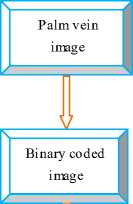
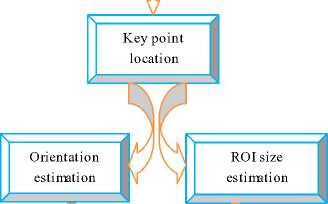

Unknown
Fig.9. Representation of palm veins image match from the database with different steps [100] [116].
In the palm veins based identification system; several types of techniques have been used for identifying the uniqueness of persons e.g. fusion method has been used to identify the uniqueness of the person. In this method palm print and palm veins images are taken, followed by enhancing the image with the help of fusion method. Fusion method is based on fusion rule.
The main issue with this technique is that the alignment of registered image is referred as pixel-by-pixel. In this method first the palm vein image is registered then line-preserving and contrast enhance image fusion process is used for combining the two or more images into single image. The fusion method performs act on the basis of wavelet technique for merging the two original palm vein images. The general wavelet transform fusion is mathematically described in Eq.(10) [88].
I (x,y) = to -1 (0(to(I i (x,y),to(l 2 (x,y)))) (10)
In Eq.(10), ω represents wavelet transform, represents fusion rule, I1 and I2 represents images. The wavelet functions used for finding the gradient direction corresponding to the edge points of an image ‘I(x, y)’ at scale ‘s’ are presented in Eq. (11) and Eq. (12) [88] .
Radon(k, b)[h(x, y)]
r + co r + CO
= I I h(x,y)6[y
‘'—CO ‘'—CO
- (kx + b)]dxdy
In Eq. (15), ‘k’ represents the slope of line and ‘b’ represents the intercept of line. Here, ‘x’ and ‘y’ locate the line segment of image.
After obtaining the line segment, the width of line with the help of Eq.(16) is obtained [114].
LRTt №) = ! (,, y)£ifc I[x,y] (16)
In Eq. (16), ‘I’ represents the two dimensional palm veins image; ‘k’ represents slope of line; ‘lk’ represents line segments of image and LRT represents the localized radon transform of palm vein image.
After finding the width of line segment of palm veins image, the hamming distance (HD) based technique is used for matching the palm veins based images. The HD technique is mathematically presented in Eq.(17) [114].
(x,y)=^)
^2
min
M(Fr , Ft= = <
VhE[-m,m],VvE[-n,n]
( h amdi st(Fr , F t h ‘ v)
,{ ||F r nF t^ || }
The wavelet transform equation corresponding to wavelet functions of Eq.(11) and Eq.(12) is mathematically defined in Eq.(13) [88] .
M^)) = s (^
МЛ) ' V)
) =
s
t7(I x 0s)(x,
y)
(13)
!
The radon transform technique was used by [114] for identifying the uniqueness of a person. This technique is based on two things namely webs and calculated minimu m distance of selected region of palm veins image. The two dimensional palm veins image is used for locating the webs between the fingers and the minimum distance of each web is calculated from local region of palm veins image. The Eq. (14) describes about finding webs between the fingers and calculating minimum distance between webs.
t^^
1 Eroi = ^^
In Eq. (14), ‘E W ’ represents the distance between two webs; ‘E D ’ represents the distance between ROI and reference line; E ROI represents the size of ROI; η and ξ represents control location and size of ROI.
The radon transform matching based technique is presented in Eq.(15) [114].
In Eq.(17), ‘Fr’ represents the registered palm vein template image; ‘Fh,vt’ represents the unknown palm vein template image translated by ‘h’ and ‘v’ pixel in horizontal and vertical direction; ‘hamdist’ represents the hamming distance between two templates; ‘m’ and ‘n’ represents the control translation in horizontal and vertical directions and ‘|| ||’ represents the cardinality operator.
-
(iv) Comparing the Performance Palm Veins Based Systems
The performance of palm veins techniques are compared with other techniques in term of effective error rate. The performance of palm veins based system is presented in table 3 and fig. 10.
Table 3. Comparison of different palm veins based identification systems [27] [36] [88] [41] [98].
|
S. No |
Techniques |
Features Used |
Results in % |
|
1 |
Affine Invariant Feature Extraction Method |
Angle of Rotation Transform |
EER < 4 (600 rotation) EER < 1 At (rotation transform 900) |
|
2 |
NMRT |
Deformations, Translation and Rotational Variations |
EER 0.320.01 |
|
3 |
Veins Pattern and Segmentation Method |
Pixel Value |
EER 1.1-3.8 |
|
4 |
LPP |
Fusion Rule |
EER 1.016 |
The results of table 3 reveal that NMRT technique gives better performance than other techniques at different rotations. The fig. 10 represents the performance graph of several palm veins based identification systems which are used for identifying individuals. The results of fig. 10 show that although all the techniques have performance above 90% but the Laplacian palm and NMRT techniques give better performance than other techniques.
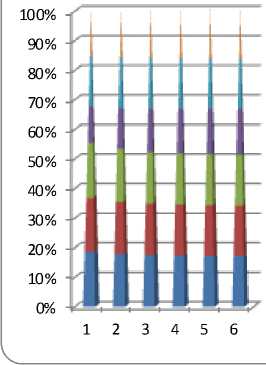
■ SIFT
■ Comp Code
■ Laplacian Palm
■ Ordinal Code
■ Hessian Phase
■ NMRT
10(a). Cone graph of several palm veins identification techniques based on their performance [114].
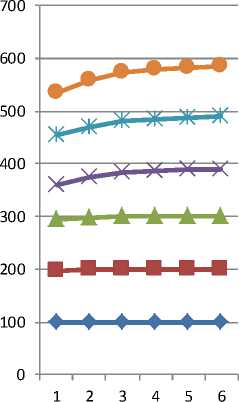
SIFT
Comp Code
Laplacian
Palm
* Ordinal Code
■ Hessian Phase
^^— NMRT
10(b). Stack line graph of several palm veins identification techniques based on their performance [114].
Fig.10. Cone and stack line graphs for palm veins based identification systems.
The stack line can be consider as another tool to measure the performance of different palm veins based techniques. The stack line graphs for different palm veins based systems are presented in fig. 10(b).
-
IV. M ULTI -V EINS B ASED I DENTIFICATION S YSTEMS
Multi-veins based biometric system uses the combination of two or more veins features based identification system for identifying individuals. Multiveins based biometric systems are categorized on the basis of combinations of head veins, face veins, palatal veins, heart veins, hand veins, palm veins and finger veins based features. The possible combinations of multiveins based biometric systems are presented in fig. 11.
In fig. 11, c 1 , c 2 , c 3 , c 4 , c 5 and c 6 are representing the combinations of veins based identification systems where two types of veins images and features are used for identifying persons. The three different types of veins images and features used for personal identification are represented by c7, c8, and c9. In fig. 11, c10 and c11 are representing a combination of four different types of veins images and features based combinations. The variables c12 and c13 use five and seven different types of veins images and corresponding features for identifying individuals.
The possible combinations of two to seven types of veins images and corresponding features based identification systems are: Face and head veins; Head and palatal veins; Palatal and heart veins; Heart and hand veins; Hand and fingers veins; Fingers and palm veins; Face, head and palatal veins; Palatal, heart and hand veins; Hand, finger and palm veins; Face, head, palatal and heart veins; Heart, hand, finger and palm veins images; Face, head, palatal, heart and hand veins images; Face, head, palatal, heart, hand, finger and palm veins images. Few important multi-veins combinations based systems are described in sections A, B, C, D and E.
-
A. Face and Head Veins Based Identification Systems
In the head and face veins based system, the face and head veins features are used for identifying the uniqueness of the persons. Each person has independent and unique head veins and face veins features. The head and face veins cannot be modified easily. Therefore, these features are widely used for identifying the individuals.
In the face and head veins based identification systems if head and face veins features together are matching with the stored database then only the person will be declared as an identified person. In other cases we declare that the mismatch situation has occurred.
The drawback of this technique is that if the head and face of the person are seriously injured in accidents and due to which the internal structure of face and head veins are distorted then it will not be possible to use head and face veins based features for identification. The plastic surgery does not affect the face veins up to very high extent. Therefore, the face and head veins based identification may work accurately in the situations where a person may have changed his / her face through plastic surgery.
-
B. Face Veins and Palatal Rogue / Veins Based Identification System
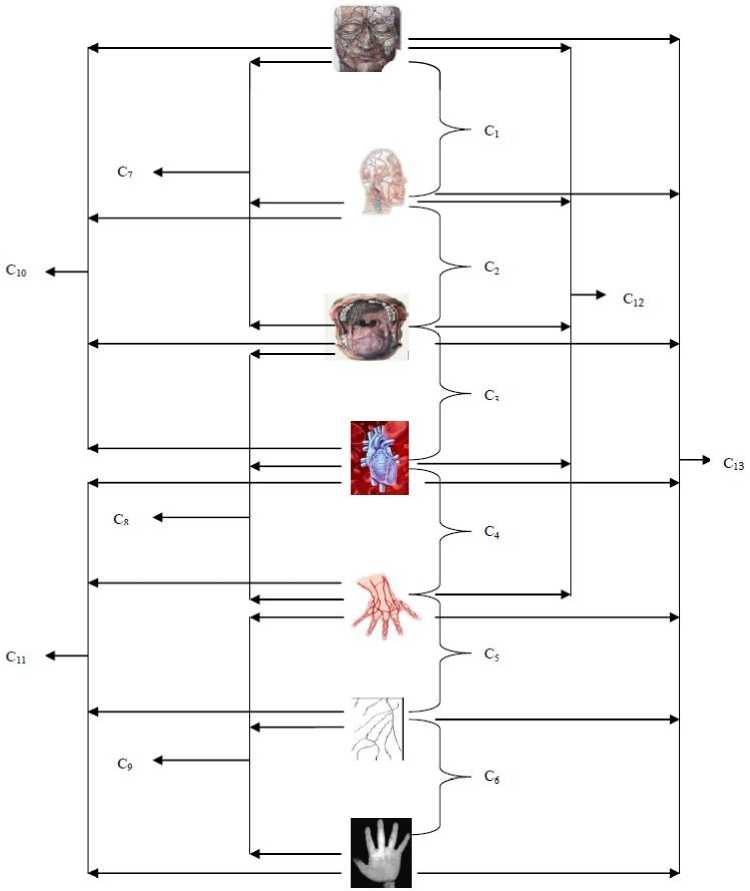
Fig.11. Possible combinations of multi-veins based biometric systems [3] [17] [43].
The benefit of face and palatal veins based approach is that if the face of a person is burned then the person can be identified with the help of palatal rogue/veins because the palatal rogue / veins may not be damaged in the case of face burnt. The disadvantage of face and palatal patterns based technique is that if the face of a person is completely damaged in an accident or due to any other reason then face and palatal patterns based technique will fail in identifying the person. The face veins and palatal rogue/veins are much secured in comparison to other veins based multi-biometric systems.
-
C. Face Veins, Hand Veins and Finger Veins Based Multi-Biometric System
The face, hand and finger veins based multi-biometric system are used for identifying the individuals. The merit of this multi-biometric system is that if any vein’s feature is destroyed, then other vein’s feature can be used for identifying the person. Otherwise, face-hand-finger veins features are used for identifying the individual. The demerit of face-hand-finger veins multi-biometric system is that usually the face, hand and fingers are burnt in burn cases. Therefore, there is high possibility that face-hand-finger veins based system will not accurately identify the persons in burn cases. This may be a reason for the failure of this technique.
The advantage of using face-hand-finger veins based identification system is that the face veins, hand veins and finger veins images are easily captured in comparison to heart and head veins. The face-hand-finger veins features based systems are widely acceptable and used in offices.
-
D. Head, Heart and Palm Veins Based Multi-Biometric System
The head, heart and palm vein based multi-biometric system is used for identifying the persons on the basis of various veins features of head, heart and palm. If all three veins features are in good condition then the persons are identified on the basis of their head, heart and veins features [12]. The merit of this system is that if the person’s head is damaged then the person can be identified with the help of heart and palm veins feature. If the heart of a person is damaged then palm and head veins features can be used for identifying the individual. If the palm of a person is destroyed in an accident then the person can be identified with the help of head and heart veins based features. Due to these reasons the headheart-palm veins based multi-biometric system plays very important role in the field of personal identification.
Table 4. The performance comparison of different multi-veins based systems [3] [17] [42] [43] [44] [47] [92] [96] [110].
|
S. No |
Multi-veins based identification systems |
Technique / Approach Used |
Description |
Advantages |
Disadvantages |
|
1. |
Fingers and iris veins based multi-veins system |
FLIRT & SVM |
This system is used to identify a person with the help of fusion of finger and iris veins features. |
|
The multi-veins based system takes more time in processing the veins images in comparison uni-veins based system. |
|
2. |
Face and fingers veins fusion based multiveins system |
FLIRT & SVM |
The face and finger veins fusion based system is used as low resolution fusion technique for identifying the uniqueness of persons. |
The face and finger veins based multiveins system is very useful for analyzing the behavior of persons and it has very low false acceptance rate (FAR) and false rej ection rate (FRR). |
The face and finger veins based multi-veins system fails to identify a person whose face and fingers are burned. The probability of burning fingers and face is very high in all burn cases. |
|
3. |
Face and palm veins based multi-veins systems |
FFT & NMRT |
The palm and face veins based multiveins system uses palm veins and face veins features for verifying the identity / uniqueness of a person. |
Palm and face veins features based system can identify a person. The behavioral analysis of a person can be success fully done with the help of palm and face veins features. |
|
|
4. |
Hand and palm veins based multi-veins system |
SVD & RT, SVM & LPP |
The hand and palm vein based multiveins system uses hand and palm veins features for identification. |
If a person’s fingers are damaged or burned then also palm and hand veins based multiveins identification system can be used for identification. |
|
|
5. |
Face and hand veins based system |
TFRS & C2 Code |
The face and hand veins based system plays an important role in the field of personal identification. Here, face veins and hand veins features used for identification. |
If a person’s fingers are damaged or burned then also face and hand veins based multi-veins system can be used for identification. |
|
|
6. |
Hand and finger veins based system |
C2 Code & SVD & RT |
The hand and finger veins based system is used for identifying the persons with the help of hand and finger vein features. |
This system is important when a person’s face is vandalized in accident and we need to identify the person. |
|
Table 5. Advantages and disadvantages of different multi-vein based identification system [3] [17] [42] [43] [44] [47] [92] [96] [110].
|
S. No. |
Multi-veins Based System |
Technique Used |
Description |
Advantages |
Disadvantages |
|
1. |
Fingers and palm veins based system |
SVM & NMRT |
The finger and palm vein based identification is used to identify the uniqueness of the person with the help of finger and palm veins. This system uses fingers and palm veins based SVM & NMRT approaches for identifying individuals. |
The advantage of this system is that if the person’s face, head and hand veins are damaged then also we can identify the persons with the help of fingers and palm veins. |
|
|
2. |
Hand, fingers and palm veins based system |
SVD & RT, SVM & LPP. |
This system uses the fusion of hand, fingers and palm veins features for identifying a person. |
If the face of a person is severely damaged because of an accident / burn then handfinger-palm veins based multi-biometric system can successfully identify the person. |
|
|
3. |
Fingers, face and palm vein based system |
C 2 Code, LWBP & HWT and NMRT. |
The fingers, face and palm veins based multimodal system is used to find the uniqueness of a person with the help of fingers, face and palm veins features. |
The fingers, face and palm veins feature multi-biometric system has low FAR (false acceptance rate) & FRR (false rejection rate) values. |
If the fingers or face of a person are seriously damaged because of an accident or burn then fingers-face-palm veins based multi-biometric system may not work appropriately. |
|
4. |
Face, hand, palm and finger veins based system |
TFRS, SVD, NMRT & C 2 Code. |
In this technique, face-fingers-palm-hand veins features are combined for identifying a person. |
The face-fingers-hand-palm veins based multi-veins system has low FAR and FRR ratios. |
If the face or fingers of a person are damaged due to an accident or burn then this multi-veins based approach may not be able to identify a person correctly. |
|
5. |
Iris, fingers, and face veins based system |
SVM and LWBP |
This technique uses fingers veins, iris veins and face veins features for personal identification. |
The iris-fingers-face veins based multi-veins system has low FAR and FRR values. This multi-veins system will have high GAR (genuine acceptance rate) and low GRR (genuine rejection rate) values. |
|
|
6. |
Fingers-face-palatal veins based system |
FLIRT & SVM |
This technique uses fingers veins, face veins and palatal veins features of a person for identification. |
The fingers-face-palatal veins based multi-veins system has low FAR and FRR values. This multi-veins system will have high GAR and low GRR values. |
If the face or fingers of a person are damaged due to an accident or burn then this multi-veins based approach may not be able to identify a person correctly if fingers-face-palatal veins features are fused together while applying them for identification. |
-
E. Comparing the Performance of Multi-Veins Based Systems
In this section, we have compared the performance of different multi-veins based systems with the help of tables 4, 5 and fig. 11. The advantages and disadvantages of these multi-veins based identification systems are described in tables 4 and 5.
-
V. C ONCLUSIONS & F UTURE W ORK
In this paper we have analyzed the performances of fingers, palm, face, iris, palates, hand and heart veins based multi-veins systems. The merits and shortcomings of these multi-veins features based systems are described.
The multi-veins based systems give better performance in terms of FAR and FRR ratios in comparison to univeins based systems. Specially, fingers-face-iris-palatal veins based multi-biometric systems always give low FAR and FRR values which can be considered as the better performance in comparison to other multi-veins based identification systems. The heart veins, hand veins, and palm veins based systems have high FAR and FRR values.
The researchers can implement fuzzy logic, soft computing, rough set and neural networks on face veins, hand veins, fingers veins, palm veins, iris veins and palatal veins based multi-biometric systems to further improve the performances of multi-veins based identification systems.
Список литературы Veins Based Personal Identification Systems: A Review
- Amirthavalli Kannika, and Kirubha D., “Thermal Imaging as a Biometrics Move Towards Facial Signature Substantiation”, International Journals of Advanced Computational Engineering & Networking, Vol. 2, No. 1, pp.54-58, 2014.
- Anand Jose, Flora T. G. Arul and Philip Anu Susan, “Finger Vein Based Biometric Security System”, International Journal of Research in Engineering and Technology, Vol. 2, pp. 197-200, 2013.
- Arandjelovic Ognjen, Hammoud B. Riad and Cipolla Robberto, “Thermal and Reflectance Based Personal Identification Methodology under Variable Illumination”, Pattern Recognition, Vol. 43, No. 5, pp. 1801-1813, 2010.
- Badawi Ahmed M., “Hand Vein Biometric Verification Prototype: A Testing Performance and Patterns Similarity”, IPCV, pp. 3-9, 2006.
- Benziane Sarah and Benyettou Abdelkader, “Biometric Technology Based on Hand Vein”, Oriental Journal of Computer Science & Technology, Vol. 6. pp. 401-412, 2013.
- Buddharaju Pradeep, Pavlidis Loannis and ManoharChinmay, “Face Recognition Beyond The Visible Spectrum”, Advances in Biometrics, Springer London, pp. 157-180, 2008.
- Chekmenev Sergey Y., Farag Aly A. and Essock Adward A., “Thermal Imaging of the Superficial Temporal Artery: An Arterial Plus Recovery Model” IEEE Conference on Computer Vision and Pattern Recognition, pp. 1-7, 2007.
- Chen Cunjian, and Ross Arun, “Evaluation of Gender Classification Methods on Thermal and Near Infrared Face Image”, IEEE Biometric International Conference, pp. 1-8, 2011.
- Chengbo Yu, Huafeng Qing, and Lian Zhang, “A Research on Extracting Low Quality Human Finger Vein Pattern Characteristics”, The Second International Conference on Bioinformatics and Biomedical Engineering, pp.1876-1879, 2008.
- Chennamma H. R., Rangarajan Lalitha, and Veerabhadrappa, “Face Identification From Manipulated Facial Images Using SIFT”, IEEE International Conference on Emerging Trends in Engineering and Technology, pp. 192-195, 2010.
- Cho Siu Yeung, Ting Chan Wai, and Quek Chai, “Thermal Facial Pattern Recognition for Personal Verification Using Fuzzy CMAC Model”, International journal of innovative, Information and Control, Vol. 7, pp. 203 – 222, 2011.
- Chu Rufeng, Liao Shengcai, Han Yufei, Sun Zhenan, Li Stan Z. and Tan Tieniu, “Fusion of Face and Plamprint for Personal Identification Based on Ordinal Features”, IEEE Conference on Computer Vision and Pattern Recognition, pp. 1-2, 2007.
- Covavisaruch N. and Prateepamornkul P., “Personal Identification System Using Hand Geometry and Iris Pattern Fusion”, IEEE International Conference on Electro/ Information Technology, pp. 597-602, 2006.
- Deepamalar M. and Madheswaram M., “An Improved Multimodal Palm Vein Recognition System Using Shape and Texture Features”. International Journal of Computer Theory and Engineering, Vol. 2, pp. 95-101, 2010.
- Ding Y., Zhuang D. and Wang K., “A Study of Hand Vein Recognition Method”, Proceedings of the IEEE International Conference on Mechatronics & Automation, pp. 2106-2110, 2005.
- E. Manjunathswamy B, J Thriveni, R Venugopal K and Patnaik L M, “Multi Model Personal Authentication Using Finger Vein and Face Images”, IEEE International Conference on Parallel, Distribution and Grid Computing, pp. 341-344, 2014.
- Ferrer Miguel A., Morales Aythami, Travieso Carlos M. and Alonso Jesus B., “ Low Cost Multimodal Biometric Identification System based on Hand Geometry, Palm and Finger Textures”, in 41st Annual IEEE International Carnahan Conference on Security Technology, pp. 52-58, 2007.
- Fuksis R.,KadikisA.andGreitans M., “Biohashing and Fusion of Palmprint and palm vein Biometric Data”, In Hand Based Biometric, pp. 98-110, 2011.
- Garbey Marc, Sun Nanfei, Merla Arcangelo, and PavlidisLoannis, “Contact-Free Measurement of Cardiac Plus Based on The Analysis of Thermal Imagery”, Biomedical Engineering, IEEE, Vol. 54, pp. 1418-1426, 2007.
- Gault Travis R., Blumenthal Nicholas, Farag Aly A., Starr Tom, “Extraction of the Superficial Vasculature, Vital Sign Waveform & Rates Using Thermal Imaging”, IEEE Computer Vision and Pattern Recognition Workshops, pp. 1-8, 2010.
- Ghiassa Reza Shoja, Arandjelovi Ognijen, Bendadaa Abdelhakim, and Maldague Xavier, “Infrared Face Recognition”, Audio – Video Based Biometrics Person Authentication, Springer Berlin Heidelberg, Vol. 47, pp. 2807-2824, 2014.
- Gopinath P., “Human Identification Based on Finger Veins- A Review”, International Journal of Humanities, Arts, Medicine and Sciences, Vol. 2, pp. 29-34, 2014.
- Guzman Ana M., Goryawala Mohammmed, and Adjouadi Malek, “Generating Thermal Signatures Using Thermal Infrared Images”, IEEE International Conference on Emerging Signal Processing Application, pp. 21-24, 2012.
- Guzman Ana M. , Goryawala Mohammed, Wang Jin, Barreto Armando, Andrian Jean, Rishe Naphtali, and Adjoua di Malek, “Thermal Imaging as a Biometrics Approach to Facial Signature Authentication”, Biomedical and Health Informatics, IEEE Journal, Vol. 17, pp.214-222, 2013.
- Hani M. Khalil and Eng P. C., “FPGA Based Embedded System Implementation of Finger Vein Biometrics”, IEEE Symposium on Industrial Electronic Applications, pp. 700-705, 2010.
- Hani M. Khalil, Nambiar V.P. and Marsono M. N., “GA-Based Parameter Tuning in Finger Vein Biometric Embedded System for Information Security”, IEEE International Conference on Communications Theory and Security. pp. 236-241, 2012.
- Hartung Daniel, Olsen Martin Aastrup, XuHaiyun, and Busch Christoph, “Spectral Minutiae for Vein Pattern Recognition”, Biometrics International Joint Conference, IEEE, pp. 1-7, 2011.
- Hartung Daniel, “Vascular Pattern Recognition and its Application in Privacy – Preserving Biometric Online – Banking System”, Ph. D. dissertation, Gjovik University College, 2012.
- Hashimoto J., “Finger Vein Authentication Technology and Its Future”, Symposium on VLSI Circuit, pp. 5-8, 2006.
- Honarpisheh Zahra and Faez Karim, “An Efficient Dorsal Hand Vein Recognition Based on Firefly Algorithm”, International Journal of Electrical and Computer Engineering, Vol. 3, pp. 30-41, 2013.
- Ibrahim M. Mohamed Syed, Naimy Faris Salman Majeed Al, Rajaji L. and Amma S. Syed, “Biometric Recognition for Safe Transaction Using Vein Authentication System”, International Conference on Sustainable Energy and Intelligent System, pp. 77-82, 2012.
- Jain A. K., Hong L., Pankanti s. and Boole R., “An Identity Authentication System Using Fingerprints” Proc. IEEE, Vol. 85, pp. 1365-1388, 1997.
- Jain A., Chen Y. and Demirkus M., “Pores and Ridges: High Resolution Fingerprint Matching Using Level 3 Features”, IEEE Transaction on Pattern Analysis and Machine Intelligence, Vol. 29, pp. 15-27, 2007.
- K Parthiban, Whai Amitabh, S Sundaramurthy and C Palanisamy, “Finger Vein Extraction and Authentication Based on Gradient Feature Selection Algorithm” pp. 143-147, 2014.
- KabacinksiR., and Kowalskii M., “Vein Pattern Database and Benchmark Result”, Electronics Letters, Vol. 47, No. 20, pp.1127-1128, 2011.
- Kathuria Madhumita, “Design of a Vein Based Personal Identification System”, International Conference on Advances in Recent Technologies in Communication and Computing, pp. 284-286, 2010.
- Kaur Rajwinder and Rani Rekha , “An Identity Authentication Using Finger Vein and Texture Images Using NN”, International Journal of Advanced Research in Computer in Computer Science and Software Engineering, Vol. 4, pp. 983-988, 2014.
- Khan Maleika Heenaye-Mamode, Khan Naushad Mamode and Subramanian, “Feature extraction of Dorsal Hand Vein Pattern using a Fast Modified PCA Algorithm Based on Cholesky Decomposition and Lanczos Technique”, World Academy of Science, Engineering and Technology, Vol. 61, pp. 279-282, 2010.
- Khan M. Heenaye-Mamode, R. K. Subramanian R. K. and Khan N. Mamode, “Representation of Hand Dorsal Vein Features Using a Low Dimensional Representation Integrating Cholesky Decoomposition”, IEEE 2nd International Congress on Image and Signal Processing, Vol. 3, pp. 17-19, 2009.
- Kommini Chaitanya, Ellanti Kamlesh and Ellanti Harsha, “Hand Dorsal Veins and Kunckle Shape Based Authentication System”, International Journal of Computer Science and Information Technologies, Vol. 2, pp. 1633-1638, 2011.
- Kong Adams, Zhang David and Kamel Mohamed, “A Survey of Palm Print Recognition”, Pattern Recognition, Elsevier Journal, pp. 1408-1418.
- Kumar MG Sanjith, and Saravanan D, “A Novel Approach To Face Recognition Based On Thermal Imaging”, International Journal of Engineering Research and Technology, Vol.3, pp. 5-9, 2014.
- Kumar Ajay and Prathyusha K. Venkata, “Personal Authentication using Hand Vein Triangulation and Knuckle Shape”, IEEE Transactions on Image rocessing, Vol. 38, pp. 2127-2136, 2009.
- Kumar A. and Zhou Y., “Human Identification Using Finger Images”, IEEE Transactions on Image Processing, pp. 2228-2244, 2011.
- Kuratate Takaaki, Riley, Marcia, Pierce Brennand, Cheng Gordon, “Gender Identification Bias Induced with Texture Image on a Life Size Retro-Projected Face Screen”, RO-MAN, IEEE International Symposium on Robot and Human Interactive Communication, pp. 43-48, 2012.
- Lavanya A, Monika S, Sowmiya M., “Thermal Imaging and Facial Recognition Using Biometric Approach”, IJESC Journal, Vol. 16, pp. 62-69, 2014.
- Lee Hyeon Chang, Park Kang Ryoung, Kang Byung Jun and Park Sung Joo, “A New Mobile Multimodal Biometric Device Integrating Finger Vein and Finger Print Recognition”, IEEE International Conference, pp. 1-4, 2009.
- Lian Z., Rui Z. and Yu C. B., “Study on the Identity Authentication System on Finger Vein”, International Conference on Bioinformatics and Biomedical Engineering IEEE, pp. 1905-1907, 2008.
- Lin C. and Fan K., “Biometric Verification Using Thermal Images of Palm-Dorsa Vein Patterns”, IEEE Transaction on Circuit and Systems for Video Technology, Vol. 14, No. 2, pp. 199-213, 2004.
- Lu Yu, Yoon Sook, Xie Shan Juan, Yang Jucheng, Wang Zhihui and Park Dong Sun, “Finger Vein Recognition Using Histogram of Competitive Gabor Responses”, IEEE International Conference on Pattern Recognition, pp. 1758-1763, 2014.
- Lu Y., Yoon S., Xie S. J. and Park D. S., “Finger Vein Identification Using Polydirectional Local Line Binary Pattern”, In Proceedings of International Conference on ICT Convergence, pp. 61-65, 2013.
- Martinez Brais, Binefa Xavier, and PanticMaja, “Facial Component Detection in Thermal Imagery “, IEEE Computer and Pattern Recognition Workshops, pp. 48-54, 2010.
- Ma H. and Wang K.J., “A Finger Vein Image Quality Assessment Using Object and Human visual system Index”, Intelligence Science and Intelligence Data Engineering, pp. 498-506, 2013.
- Mekyska Jiri, Duro Virginia Espinosa, and Zanuy Marcos Faundez, “Face Segmentation: A comparison Between Visible and Thermal Image”, IEEE International Carnahan Conference on Security Technology, pp.185-189, 2010.
- Mulyono D.and Hrong S.J., “A Study of Finger Vein Biometric for Personal Identification”, International Symposium on Biometrics and Security Technologies, pp. 1-8, 2008.
- Miura Naoto, Nagasaka Akio and Miyatake, “Feature Extraction of Finger-Vein Patterns Based on Repeated Line Tracking and Its Application to Personal Identification”, Machine Vision and Applications, pp. 194-103, 2004.
- Miura N., Nagasaka A., Miyatake T., “Extraction of Finger Vein Patterns Using Maximum Curvature Points in The Image Profiles”, IEICE- Transitions on Information and Systems, pp. 1185-1194, 2007.
- Mottl Vadim, Kopylov Andrey, Kostin Alexey, and Yermakov Alexey, “Elastic Transformation of the Image Pixel Grid for Similarity Based Face Identification”, Pattern recognition, Proceedings, of IEEE International Conference, Vol. 3, pp. 549-552, 2002.
- Nandini C., C. Ashwini, Aparna Medha, Ramani Nivedita, Kini Pragnya and K. Sheeba, “Biometric Authentication By Dorsal Hand Vein Pattern”, International Journal of Engineering and Technology, Vol. 2, pp. 837-840, 2012.
- Negied Nermin K., “Moving Toward Thermal Imaging”, International of Recent technology and Engineering, Vol. 2, pp. 73-77, 2014.
- Nithyakalyani K., and Jayanthi T. “Face Recognition As A Biometrics Approach Using Thermal Images”, International Journal of Advances in Science Engineering and Technology, Vol.2, pp. 93-98, 2014.
- Osia Nnamdi, and Bourlai Thirimachos, “Holistic and Partial Face Recognition in the MWIR Band Using Manual and Automatic Detection of Face Based Features”, Homeland Security, IEEE Conference on Technology, pp. 273-279, 2012.
- Ravikant C. and Kumar A., “Personal authentication using finger knuckle surface”, Information Forensics and Security, Vol. 4, pp. 98-110, 2009.
- Reillo R. Sanchez, Saavedra, Jimenez and Kwon Y.B., “Changes to Vascular Biometric System Security & Performance”, IEEE Aerospace and Electronic Systems Magazine, pp. 4-14, 2009.
- Rosdi B. A., Shing C. W. and Saundi S. A., “Finger Vein Recognition Using Local Binary Pattern”, Sensor, Vol. 11, pp. 11357-11371, 2011.
- Seal Ayan, Ganguly Suranjan, Bhattacharjee Debotosh, Nasipuri Mita, Basu, and Dipak Kumar, “Minutiae Based Thermal Human Face Recognition Using Label Connected Component Algorithm”, International Conference on Computer Communication, Control and Information Technology, Vol. 4, pp. 604-611, 2012.
- Seal Ayan, Ganguly Suranjan, Bhattacharjee Debotosh, Nasipuri Mita, Basu, and Dipak Kumar, “Comprative Study of Human Thermal Face Recognition Based on Haar wavelet Transformation (HWT) and Local Binary Pattern (LBP)”, Computational Intelligence and Neuroscience , Vol. 17, pp.1-12, 2012.
- Seal Ayan, Bhattacharjee Debotosh, Nasipuri Mita, Basu, and Dipak Kumar, “Minutiae Based Thermal Face Recognition using Blood Perfusion Data”, Procedia Technology, Vol. 3, pp. 604-611, 2013.
- Seal Ayan, Ganguly Suranjan, Bhattacharjee Debotosh, Nasipuri Mita, Basu, and Dipak Kumar,“ Automated Thermal Face Recognition Based on Minutiae Extraction” ACM International Journal of Computational Intelligence Studies, Vol. 2, pp. 133-156, 2013.
- Shan Shiguang, Gao Wen, and Zhao Debin, “Face Identification From A Single Example Image Based on Face Specific Sub Space”, IEEE International Conference on Acoustics, Speech and Signal Processing, Vol. 2, pp. II(21-25), 2002.
- Song W., Kim T., Kim H. C., Choi J. H. Kong H. and Lee S., “A Finger Vein Verification System Using Mean Curvature”, Pattern Recognition Letters, Vol. 32, pp. 1541-1547, 2011.
- Soni Mohit, Gupta Sandesh, Rao M. S. and Gupta Phalguni, “A New Vein Pattern-Based Verification System”, International Journal of Computer Science and Information Security, Vol. 8, pp. 58-63, 2010.
- Sree V, Krishna and Rao P. Sudhakar, “Dorsal Hand Vein Pattern Authentication By Hough Peaks”, International Journal of Research in Engineering and Technology, Vol. 3, pp. 16-22, 2014.
- Srivastava Prakash Chandra, Agrawal Anupam, Mishra Kamta Nath, Ojha P. K. and Garg R., “Fingerprints, Iris and Feature Based Multimodal Systems: A Review”, International Journal Information Technology and Computer Science,Vol. 5, No. 2, pp. 88-111, 2013.
- Sun D. M., Liu D. and Liu H., “ Two Modality Based Bi-Finger Vein Verification System”, Proc. of International Conference on signal Processing, pp. 1690-1693, 2010.
- Trujillo Leonardo, and Olague Gustavo, Hammoud Riad, Hernandez Benjamin, “Automatic Feature Localization in Thermal Images for Facial Expression Recognition”, Computer Vision and Pattern Recognition Workshops, IEEE Computer Society Conference, Vol. 3, pp. 14-14, 2005.
- Tan Dun, Yang Jinfeng and Shi Yihua, “A Hierarchal Framework for Finger vein Image Classification”, IEEE, Asian Conference on Pattern Recognition, pp. 833-837, 2013.
- Tanaka T. and Kubo N., “Biometric Authentication by Hand Vein Patterns”, SICE Annual Conference, Vol.1 pp. 249-253, 2004.
- Tang Chaoying, Zhang Hengye, Kin Kong Adms Wai and Craft Noach, “Visualizing Vein Patterns from Color Skin Images Based on Image Mapping for Forensics Analysis”, 21st IEEE International Conference on Pattern Recognition, pp. 2387-2390, 2012.
- Tang C., Kong A.W.K. and Craft N., “Uncovering Vein Pattern From Color Skin Images for Forensics Analysis”, CPVR, pp. 665-672.
- Tang Darun, Huang Beining, Li Rongfeng and Li Wenxin, “A Person Retrieval Solution Using Finger Vein Patterns”, IEEE International Conference on Pattern Recognition, pp. 1306-1309, 2010.
- T. R. Dary Ram., “An Embedded Finger Vein Recognition System”, International Journal of Research in Engineering and Technology, Vol. 3, pp. 70-74, 2014.
- Uesugi Shiro, Okada Histoshi and Sasaki Toko, “The Impact of Personality on Acceptance of Privacy-Sensitive Technologies: A Comparative Study of RIFD and Finger vein Authentication System”, Technology and Society IEEE International Symposium, pp. 111-122, 2010.
- Wang L., Leedham G. K. and Cho D., “Minutiae Feature Analysis for Infrared Hand Vein Pattern Biometrics”, The Journal of Pattern Recognition Society, Vol. 41, pp. 920-929, 2008.
- Wang L. and Leedham G., “A Thermal Hand Vein Pattern Verification System”, ICAPR, LNCS, pp. 58-65, 2005.
- Wang Lingyu and Leedham G., “Gray-Scale Skeletonization of Thermal Vein Patterns Using the Watershed Algorithm in Vein Pattern Biometrics”, The International Conference on Computational Intelligence and Security, Vol. 2, pp. 1597-1602, 2006.
- Wang Ning, Li Qiong, A. Ahmed, Abd E1-Latif, Peng Jialing, NiuXiamu, “Multibiometric Complex Fusion for Visible and Thermal Face Images”, International Journal of Signal Processing, Image Processing and Pattern Recognition, Vol.6, pp. 1-16, 2013.
- Wang Jian Gang, Yau Wei –Yun, Suwandy Andy and Sung Eric, “Fusion of Palm Print and Palm Vein Images for Person Recognition Based on ‘ Laplacian palm’ Feature”, Computer Vision and Pattern Recognition, IEEE International Conference, pp. 1-8, 2007.
- Wang Jian Gang, Sung Eric, “Facial Feature Extraction in an Infrared Image by Proxy with a Visible Face Image”, Instrumentation and Measurement IEEE Transaction, Vol. 56, pp. 2057-2066, 2007.
- Wang K., Yuan Z., “Finger Vein Recognition Based on Wavelet Moment Fused with PCA Transform”, Pattern Recognition and Artificial Intelligence, Vol. 20, pp. 692-697, 2007.
- Wong Wai Kit, Hui Joe How, “Face Detection in Thermal Imaging Using Head Curve Geometry”, Image and Signal Processing IEEE International Congress, pp. 881-884, 2012.
- Wang Desong, Li Jianping, and Memik Gokhan, “User Identification Based on Finger – vein Patterns for Consumer Electronic Devices”, IEEE Transactions on Consumer Electronic, pp.799-804, 2010.
- Wei Shangging and GuXiaodong, “A Method for Hand Vein Recognition Based on Curve let Transform Phase Feature”, International Conference on Transportation, Mechanical and Electrical Engineering, pp. 1693-1698, 2011.
- Wu J. D. and Ye S. H., “Driver Identification Using Finger Vein Patterns with Radon Transform and Neural Network”, Expert System Application, Vol. 36, pp. 5793-5799, 2009.
- Xi Xiaoming, Yang Gongping, Yin Yilong and Meng Xianjing, “Finger Vein Recognition with Personalized Feature Selection”, pp. 11243-11259, 2013.
- Xiuyan Li, Changyun Miao, Tiegen Liu and Chenhu Yuan, “Research on Personal Identity Verification Based on Hand vein, Iris and Fingerprint”, IEEE International Symposium on Computer Science and Society, pp. 16-19, 2011.
- Xueyan Li and Shuxu Guo, “The Fourth Biometric-Vein Recognition”, Pattern Recognition and Techniques, Technology and Application, pp. 537-546, 2008.
- Yu Yibin, Tang Yaofang, Cao Jinguo and Gan Jun Ying, “Multispectral Palm Print Recognition Using Score - Level Fusion”, IEEE International Conference on Green Computing and Communications and IEEE Internet of Things and IEEE Cyber, Physical and Social Computing, pp. 1450-1453, 2013.
- Yuksel A, Akarun L and Sankur B, “Hand vein biometry based on geometry and appearance methods”, The Institute of Engineering and Technology, Vol. 5, pp. 398-406, 2011.
- Yuan Wei-Qi and Li Wei, “A Palm Vein Feature Extraction Method based on Affine Invariant”, Robotics and Biometrics, IEEE International Conference, pp. 2323-2326, 2012.
- Yang Jinfeng, Shi Yihua, Yang Jinli and Jiang Lihui, “A Novel Finger-Vein Recognition Method With Feature Combination”, Image Processing, IEEE International Conference, pp. 2709-2712, 2009.
- Yang Jinfeng and yang Jinli, “Multi-channel Gabor Filter Design For Finger- Vein Image Enhancement”, IEEE International Conference on Image and Graphics, pp. 87-91, 2009.
- Yang Jinfeng and Wang Junjie, “Finger-Vein Image Restoration Considering Skin Layer Structure”, IEEE International Conference on Hand Based Biometrics, pp.1-5, 2011.
- Yang Wenming, Rao Qing, Liao Qingmin, “Personal Identification for Single Sample Using Finger Vein Location and Direction Coding”, IEEE International conference on Hand Biometrics, pp. 1-6, 2011.
- Yang Wenming, Huang Xiaola, and Liao Qingmin, “Fusin of Finger Vein and Finger Dorsal Texture for Personal Identification Based on Comparative Competitive Coding”, Image Processing,19th IEEE International Conference on Image Processing, pp. 1141-1144, 2012.
- Yang Yongming, Lin Kunming, Han Fengling and Zhang Zulong, “Dynamic Weighting for Effective Fusion of Fingerprint and Finger Vein”, Progress in Intelligent Computing and Applications, Vol. 1, pp. 50-61, 2012.
- Yang J. F., Shi Y. H. and Yang J. L., “Personal Identification Based on Finger Vein Feature”, Computers in Human Behavior, pp. 1565-1570, 2011.
- Zhang Zhong Bo, Wu Dan Yang, Ma Si Liang and Ma Jie, “Multi Scale Feature Extraction of Finger Vein Patterns Based on Wavelet and Local Interconnection Structure Neural Network”, IEEE International Conference , pp. 1081-1084, 2005.
- Zhang Jing and Yang Jinfeng, “Finger – Vein Image Enhancement Based on Combination of Gray Level Grouping and Circular Gabor Filter”, IEEE International Conference, 1-4, 2009.
- Zhang L., Zhang L., Zhang D. Zhu H., “Ensemble of Local and global Information for Finger – Knuckle- print Recognition”, Pattern Recognition, Vol. 44, pp. 1990-1998, 2011.
- Zhang H., Tang C., Kong A.W.K. and Craft N., “Matching Vein Pattern for Forensic Investigation” The IEEE Conference on Biometrics: Theory, Application and Systems, 61-66, 2012.
- Zhang L., Qin H. and Yu C., “Study on the Finger Vein Image Segmentation Algorithm”, Piezoelectectrics & Acorstooptics, Vol. 30, pp. 233-235, 2008.
- Zhao S., Wang Y. and Y. Wang Y., “Extracting Hand Vein Patterns from Low Quality Images: A New Biometric Technique Using Low Cost Devices”, IEEE 4th International Conference on Image and Graphics, pp. 667-671, 2007.
- Zhou Yingbo and Kumar Ajay, “Human Identification Using Palm-Vein Images”, IEEE Transactions on Information Forensics and Security, Vol. 6, pp. 1259-1274, 2011.
- Zhou Yingbo and Kumar A., “Contactless Palm Vein Identification Using Multiple Representations”, Fourth IEEE International Conference on Biometric: Theory Applications, pp. 1-6, 2010.
- Zhang Lin, Zhang Lei and Zhang David, et al, “On Line Finger-Knuckle-print Verification for Personal Identification”, Pattern Recognition, Vol. 43, pp. 2560-2571, 2010.

